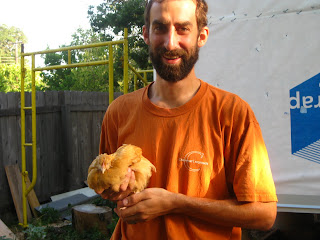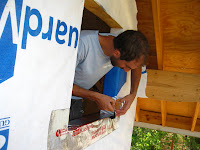Trinity wants a dog even more than she wants the house to be finished, and we've been working on extending our fences to enclose the yard completely so we can go down to the pound and get a pooch. As I've been saying, building a fence will be the first half of our security system, a big mean dog will be the second half.
 |
| Jesse measures the "glass mulch" into the mixer. |
We have an alley that gives access to the back of the property, and we wanted to make a gate that can open up enough so that if we have to drive a vehicle through it we'll be able to. We have a bunch of salvaged doors, and we're going to make a giant accordion style bi fold gate with hinges and casters. To make it easy for the casters to roll smoothly on a level surface, we needed a concrete pad.
 |
| Pouring the mix. |
Because the pad will not be required to do very much structurally, we decided to save some money and make use of local, free recycled "glass mulch" from the city waste services department. Basically, in addition to recycling glass, the city of Austin takes bottles that it collects and grinds them down into a fine gravel. It makes this available to whoever wants this, most people use it in planter beds or as a glittery ground cover. (Two years ago we used the same glass mulch to fill a succulent planter in the front yard, and the cactus seem to thrive in the sandy glass mixture.) So, after some discussion and research, we settled on a ratio of cement, crushed glass and water. In the top photo you can see me carrying a small bin to the mixer, we used the bin as our measuing cup for cement and glass and measured the water by eyeball. I think we probably would have gotten a stronger mix by adding some sand to help the concrete fill the voids a little better. The glass mixture is partially sand, but more would have helped. However, the pad seems like it has cured up nicely. I will post photos soon of the pad now that it's cured.
 |
| Trinity spreading the wet cement. You can see the pile of broken glass on the black tarp in the background. |
I'm not sure where the materials in the concrete mix they sell here comes from, but the cement we bought was locally produced, and the glass aggregate was local as well, in addition to being reused. So long as the pad doesn't start crumbling in a few months, it seems for now like a successful experiment.



















 My nephew, Miles came down at the beginning of July to help us out with the siding. Brave man to come to TX in the summer to learn some construction! The hardie looks yellow b/c it's pre-primed but we're thinking of going with a color called Florida Keys blue.
My nephew, Miles came down at the beginning of July to help us out with the siding. Brave man to come to TX in the summer to learn some construction! The hardie looks yellow b/c it's pre-primed but we're thinking of going with a color called Florida Keys blue.

 A little chicken wandered into the yard the other day and found some new friends. Her wing was a little hurt. We introduced her to the cats, decided Mj Tom wasn't the best chicken sitter and put her in a box with some mud, food and water. Much to Jesse's shigrin, I put up some signs for a lost chicken . The next day she looked rough so Jesse brought her to the pound for more attention. That afternoon we received a phone call from a neighbor looking for their chicken. So we passed on the pound info and said a little prayer for their reunion.
A little chicken wandered into the yard the other day and found some new friends. Her wing was a little hurt. We introduced her to the cats, decided Mj Tom wasn't the best chicken sitter and put her in a box with some mud, food and water. Much to Jesse's shigrin, I put up some signs for a lost chicken . The next day she looked rough so Jesse brought her to the pound for more attention. That afternoon we received a phone call from a neighbor looking for their chicken. So we passed on the pound info and said a little prayer for their reunion.
 So In this post we're gonna do an in depth look at our window installation. Hope you enjoy!
So In this post we're gonna do an in depth look at our window installation. Hope you enjoy! 





 Then he take both legs of the other half and secures one half long the jamb to the exterior and the other half along the sill to the exterior.
Then he take both legs of the other half and secures one half long the jamb to the exterior and the other half along the sill to the exterior.